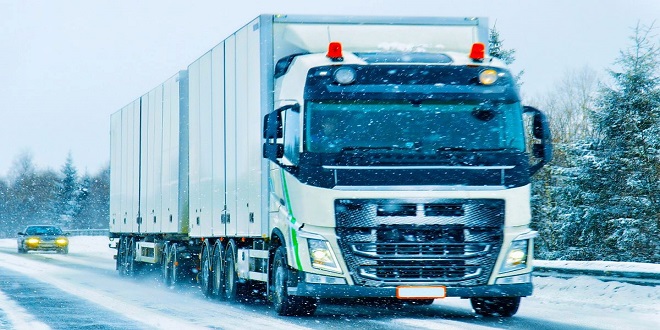Navigating the Roads in Winter as an HGV Driver

The importance of winter driving preparation
Winter driving can be treacherous, with icy roads and poor visibility making it difficult to maintain control of your vehicle. That’s why it’s crucial to prepare for winter driving before the first snowfall. Make sure your vehicle is equipped with snow tires or chains, and pack an emergency kit with blankets, food, and water. It’s also important to check your vehicle’s brakes, battery, and lights to ensure they’re in good working order. By taking the time to prepare, you can stay safe on the road this winter. Remember, a little preparation can go a long way when it comes to winter driving.
Essential items to keep in your HGV during winter months
Expert HGV driver courses will give you insight into how winter months can pose a significant challenge for HGV drivers. Cold weather and hazardous road conditions can make it difficult to drive, so it’s essential to be prepared. Keeping certain items in your HGV can make all the difference in case of an emergency. Ensure you carry warm clothing, a sleeping bag, and blankets. Comprehensive first-aid kit with extra medication, supplements, and food. A torch, spare batteries, and flares can also come in handy, should you find yourself stranded in a low-light situation. It’s always a good idea to have some tools around for any small repairs or maintenance jobs you may need to perform. Lastly, carrying a shovel and traction mats will help you in case your vehicle gets stuck in snow or mud. Remember, safety comes first – especially during the winter months!
Top tips for navigating snowy and icy roads
Winter weather can make driving a challenge, especially when snow and ice make the roads slippery. To stay safe on the road, there are a few things you can do. Firstly, slow down and leave extra room between you and the vehicle in front. This can help you avoid sudden stops and skids. Secondly, make sure your vehicle is prepared for winter weather with good quality tires and brakes. Thirdly, avoid sudden movements while steering and breaking, and try to steer in the direction you want to go if you start to slide. Finally, never panic and always plan your route in advance, taking into account any potential hazards caused by snow or ice. By taking these simple steps, you can stay safe and confidently navigate snowy and icy roads.
How to properly clear snow and ice off your HGV
Winter weather can wreak havoc on the roads. When snow and ice start to build up, it’s important to clear your HGV before hitting the road. Not only will it improve your visibility and safety on the road, but it’s also a legal requirement. First things first, make sure you have the right tools for the job, such as a scraper, brush, and de-icer. Start by clearing the snow from the roof of your vehicle and working your way down. Be sure to also clear your headlights, taillights, mirrors, and licence plates. When using de-icer, follow the instructions carefully and use it sparingly. Avoid using hot water, as it can cause the glass to crack due to the sudden temperature change. With these tips, you can safely navigate the winter roads.
The dangers of black ice and how to spot it
Black ice is a common winter hazard that can turn any road or pavement into a dangerous slippery surface. Unlike other types of ice, it is nearly invisible to the naked eye, making it an unexpected threat for drivers and pedestrians alike. Black ice forms when the temperature drops below freezing point causing a thin layer of ice to form on top of the road surface. It is important to know how to spot black ice to avoid accidents or injuries. Keep an eye out for glossy or shiny spots on the road, particularly in shaded areas, since this is where black ice is likely to form. Also, be aware of sudden temperature changes, as these can also contribute to black ice formation. Always be alert and cautious when travelling during the winter months to stay safe on the roads.
Staying alert and aware while driving in extreme weather conditions
When driving in extreme weather conditions, it is crucial to remain alert and aware of your surroundings. For instance, during heavy rain or snow, it can be difficult to see the road clearly, so it’s important to slow down and maintain a safe distance from other vehicles. When driving on slippery roads, remember to brake gently and avoid sudden movements that could cause you to lose control of the vehicle. In foggy conditions, use your headlights to make yourself visible to other drivers, and stay in the right lane to avoid oncoming traffic. By taking these simple steps, you can help ensure your safety and that of other road users while driving in extreme weather conditions.
Knowing when to pull over and wait out a storm
Driving in inclement weather can be hazardous, especially when a storm is in full force. Knowing when to pull over and wait out a storm can make all the difference in staying safe on the road. If visibility is severely reduced or the roads are treacherous, it’s important to find a safe place to park until the storm passes. This could be a rest stop, gas station, or a parking lot. Stay put until the storm has passed and it’s safe to resume driving. It’s always better to be safe than sorry, so make sure you’re prepared with blankets, food, and water just in case you’re stranded for a prolonged period of time. Remember, pulling over and waiting out a storm is the wise choice and could save your life.
Recommended routes for HGV drivers during winter months
When it comes to navigating the roads during the winter months, HGV drivers face a unique set of challenges. To ensure a safe and successful journey, it’s important for drivers to plan their routes carefully and take into account factors such as weather conditions, road closures, and traffic volumes. Some recommended routes for HGV drivers during the winter months include major highways and motorways that are frequently cleared and salted, as well as alternative routes that may be less busy but still offer safe and reliable passage. By staying informed and prepared, HGV drivers can confidently navigate the roads this winter and arrive at their destination on time and in one piece.
Maintaining your vehicle’s performance during cold weather
Winter brings with it some unique challenges for drivers, especially when it comes to maintaining the performance of your vehicle. Cold weather can put added strain on your vehicle’s engine, battery, and other systems, causing a range of issues and potentially leading to breakdowns if not addressed properly. There are several things you can do to help ensure your vehicle is up to the task of winter driving, starting with regular maintenance and inspections. From checking your antifreeze levels to swapping out your tires for winter ones, there are several steps you can take to keep your vehicle running smoothly and safely throughout the season. With a little bit of effort and attention to detail, you can help ensure your vehicle stays in top shape throughout the colder months and beyond.
Safety reminders for other drivers on the road during winter
Winter driving can be a challenge for any driver, no matter how experienced they are. With slippery roads, limited visibility, and unpredictable weather conditions, it’s important to stay alert and cautious at all times. As a responsible driver, it’s essential to take steps to ensure your safety and the safety of others on the road. With that in mind, here are some safety reminders worth keeping in mind during winter driving. First, always slow down and maintain a safe distance from other vehicles. Secondly, be mindful of the weather forecast and consider postponing your trip if it’s not absolutely necessary. Finally, make sure your vehicle is fully prepared for the winter months, with appropriate tires, fluids, and emergency supplies in case of unexpected breakdowns. By following these safety tips, you’ll be more likely to navigate the roads with ease and peace of mind this winter.
The impact of severe weather on delivery times and how to communicate with clients
Severe weather can throw a wrench in the delivery process, causing delays and impacting client satisfaction. It is important to communicate with clients in a timely and transparent manner, letting them know about any potential delivery delays. Providing alternative delivery options or keeping the client updated on the status of their shipment can help alleviate any concerns they may have. Additionally, it is crucial for companies to have contingency plans in place for severe weather situations, such as rerouting shipments or adjusting delivery schedules. By being proactive and communicating effectively, businesses can reduce the impact of severe weather on delivery times and maintain strong client relationships.
This information can be even more useful if you are a driver or interested in HGV or HDR driver job opportunities. Driving carefully during winter months and bad weather conditions is a must for all drivers on the road, while being extra careful is a rule for those who work as a driver.
Conclusion
Winter driving can be challenging for any driver, but it’s particularly important for HGV drivers to be prepared and responsible. Staying safe on the roads means taking extra precautions in poor weather conditions, including reducing speed, keeping a safe distance from other vehicles, and checking road conditions before setting out on a journey. Being responsible also means making sure your vehicle is well-maintained and equipped with the necessary equipment for winter driving, such as snow chains or antifreeze. Preparation is key, so always plan your route in advance and check for any weather alerts or road closures along the way. By following these guidelines, HGV drivers can stay safe on the roads and ensure deliveries are made on time, no matter the weather.
In conclusion, it is clear that winter driving brings unique challenges for HGV drivers. It requires preparation, caution and a deep understanding of safe driving practices in extreme weather conditions. As we have discussed, there are essential items to keep in your vehicle, top tips for navigating snowy and icy roads, and important techniques for clearing snow and ice off your HGV. Additionally, being aware of the dangers of black ice, staying alert on the road, and knowing when to pull over during a storm are crucial for a safe journey. Remember to always plan your routes carefully and communicate any potential delays with clients due to severe weather conditions. As an HGV driver, it is our responsibility to not only keep ourselves safe but also others on the road. Let us all strive to maintain our vehicles’ performance during cold weather and be vigilant for other drivers who may not be as familiar with winter driving. With these measures in place, we can confidently navigate through the winter months and reach our destinations safely. Stay prepared, stay responsible, and stay safe out there on the roads this winter! And remember: at the end of the day, nothing is more important than our well-being and those around us. So let’s make sure we do everything in our power to ensure everyone arrives home safely. Thank you for reading this blog post on winter driving preparation as an HGV driver – now let’s put these tips into practice!




